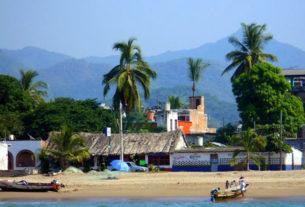A Voice from Oaxaca
Transporting your worldly possessions into Mexico is both an art and a science, even more so if you intend to do so on your own… truck and all. Then the task also becomes a challenge and an adventure. No matter what the Canadian or American Consul in Oaxaca advises, and regardless of the steps the Mexican counterpart in your city of origin states you must follow, you’ll be met with surprises. Having survived the feat, traveling about 5,000 km over eight days from Toronto in a grossly over-weighted three-ton cube van qualifies me to shed light on the process and make it easier for others.
Before deciding to make the trek on your own rather than hire a mover (which has its own set of complications,) crunch the numbers. Can your vehicle make the journey? If not, what will it cost to buy a truck that can make the trip safely without breaking down, as opposed to paying third parties (brokers, transport companies, etc.?) What will fuel, tolls, meals and hotels cost for two? A former long-haul truck driver friend made the trip with me since a solo effort is extremely arduous. Check to ensure that once you’ve reached your destination in the Republic, you’ll be permitted to sell that particular make, year and model of van. Contrary to popular belief, not all foreign vehicles at least ten years old can be sold here. Do you really want to be burdened with a large truck in southern Mexico that you can drive but not sell, rent or use for remunerative purposes?
To import household contents – menaje de casa – you must list every item, in both Spanish and English, making several copies. You’ll need the copies to present to the Mexican authorities at the border and for the initial permission you’ll be seeking in your soon-to-be former home city. Each electronic and electrical item must include make, model and serial number. Extra copies are a help for when you’re stopped by police once you’ve entered Mexico, and to cross reference when the actual border ordeal is upon you.
Canadian Consul Frances May impressed one point upon me: make the list as detailed as possible, because if you omit a paperclip that’s in a box, and the authorities at the crossing find it, they’ll make you unpack everything. We went to great lengths to follow her advice, starting the enumerating and packing months before departure so as to not be overwhelmed doing everything in a couple of weeks. A 35-page typed single spaced list, with translation, enumerating the contents of some 200 boxes as well as furniture, was presented to the Mexican consul at Toronto a couple of days prior to departure. “Too much, it’s not reasonable for a family to have such a quantity, so we won’t give our approval,” we were told. And some items were possibly prohibited (be careful with foods, liquor, cleaning products, collectibles, etc.)
Damned if we were going to unpack the truck and go through every box, leaving behind what we’d spent a lifetime accumulating. We’d already pared down our possessions through a contents sale. Solution? We condensed all into five pages, by combining items and being creative in terms of listing and categorizing. We placed virtually the same items in a different format and received the Mexican Government’s blessing (and more importantly, stamp of provisional approval — border personnel have the ultimate authority.)
How does one do it? Make the contents appear to be less and illustrative of where in a home items will go. For example, if you have four TVs in fpur different boxes, list them on one or two lines instead of seven to eight lines, with the initial word “Television(s)”, then putting abbreviated descriptions and where each will go (i.e. lr, br). In this way you’ve more than halved the verbiage and shown that your home reasonably accommodates what you’re bringing. Do the same thing with artwork. We had collectible glassware in perhaps 30 different boxes, again the contents of each box listed in detail. Second time around we listed on a couple of lines instead of 50 lines, “87 pieces of collectible green depression glass.” This “official” list didn’t have box numbers, although we still took with us, safely hidden away, the original enumeration with box numbers, just in case.
We had anticipated spending a half a day at the Canada-U.S. border. Instead, after three minutes we were waived through, without even having to open the truck’s back door, simply because we were able to present the original list to the border patrolwoman. The last thing she was interested in doing was burden a colleague with spending hours searching through a truck which was to her, packed meticulously.
Crossing at Laredo was different. Make sure you know from which of the potential bridge crossings you are to enter Mexico. There is merit in choosing a city with only one crossing. Do not arrive on a Friday afternoon. Our border point was closed from 4 p.m. Friday until Monday morning. Since the steps required to ultimately get into the country are time-consuming, migración probably won’t even start with you much after noon on a Friday. We arrived after 3 p.m. and had to spend the weekend in Laredo. You can still buy your vehicle insurance (wise but possibly not mandatory,) secure the permit to drive the truck in the country, and walk across into Mexico to spend a few hours sightseeing.
Negotiating your way through the actual border can take a full day, in our case seven hours. While we were led to believe that having a customs broker is not a prerequisite, somehow we became convinced that it was the way to go. Dollars and hours later, our man had gone through some of our boxes and approved the next step, a meeting with the licenciada (immigration official, technically anyone with a university degree) “at the docks.” This is where all our advance effort paid off. No matter how straight you think you are in terms of following the rules, there’s always the worry that you might have forgotten to list something, put a paperclip in the wrong box or brought a prohibited product. A provocatively dressed young female border official seemed to enjoy toying with us as she bent over to examine contents of boxes she ordered removed from the truck by her two male designates in 100 degree heat. She had before her the five page list, from which she demanded to see various items. Our master list told us in which box to look, and an oversized bristol board legend directed us to the quadrant of the truck in we would find each box. “Salma” never backed down, even when told that the JVC Receiver she wanted to examine was stowed mid-truck in a bottom box.
Eventually we made it through this stage, a blueprint for others. Our broker used us as an example as to how to list contents, when explaining to a couple of would-be immigrants that they couldn’t even get to the unloading dock.
After satisfying our dutiful official, we were required to then pass a further checkpoint, whereupon if you push the button and get the red light, another border employee makes you jump through the same hoops. Green it was!
On the highways, in the US, we simply flew by all weigh stations, knowing we were overweight and fearing being fined and sent back to each state line. There’s always a patrol car at the scales waiting to pull you over. Although the van was large and registered commercial, a touristy-looking passenger putting his feet up on the dash and appearing to be reading a book may tip the balance as it did for us time and time again. A breakdown in Smalltown, Kentucky, was our only setback, but after five hours we were on the road again.
Rules to follow include: don’t drive after dark, eat well in good restaurants, and stay in comfortable motels. It makes the trip much more pleasant. In Mexico, use the “no-tell” motels, since they tend to be extremely luxurious and inexpensive, albeit without lobbies or much in the way of staff. The owners of the motels count on a heavy nightly turnover from repeat business… as opposed to travelers.
Oaxacans caution to avoid driving through Mexico City because of traffic, and more importantly the custom of police pulling over out-of-state trucks to exact a “toll.” There’s also the regulation regarding on which days vehicles with plates ending in what numbers can drive through the D.F. We traversed the capital over two and a half hours during rush hour, no other large trucks to be seen (probably prohibited at this time or altogether from being on these highways), only once hearing a patrol car’s siren several cars back. Both we and its occupant simply carried on, the traffic being too intense for either of us to reach the other.
On the final day of the trek, a Puebla state trooper pulled us over, checked all our documentation, and after a brief exchange of pleasantries we were on the last leg of our journey, with nary a regret. Such an adventure complements and is a great start to the lifestyle change upon which you’re embarking.


